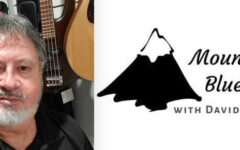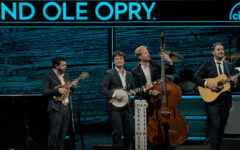
Occasionally, we share the content of our bi-monthly newsletter, Sound Marketing For Bluegrass, to give non-subscribers a taste of the content offered in this free email service. As these last two covered important topics in the world of radio, we think many readers will enjoy them.
If you would like to sign up to receive these updates about bluegrass marketing in today’s digital world by Barry Silverstein, use the signup form to the right. It also allows you to sign up for our daily digest of bluegrass news, The Bluegrass Buzz.
A while ago, I wrote about the growth of radio and how bluegrass marketers could make the best use of radio advertising. This month, I’m going to depart from my typical discussion of marketing to share a perspective on the future of radio. More than any other medium, radio has an enduring effect on bluegrass fans. But there are big changes coming to radio that all bluegrass marketers need to know about.
Last month, the North American Broadcasters Association (NABA) held a symposium on the “Future of Radio and Audio.” The new FCC Chairman, Ajit Pai, made remarks at the symposium, some of which bear mentioning. “Each week, 93% of Americans over the age of twelve still listen to the radio, which is about the same as a decade ago, and the decade before that, and the decade before that,” he said. “That’s over 245 million Americans. And they aren’t just listening to the radio just to catch a single from Adele. They are listening on average for twelve hours a week… The enduring popularity of radio amidst so much technological disruption is truly striking…”
Pai went on to say that, while the future of digital media is being defined by three forces, namely “social, local, and mobile,” radio is already social, local, and mobile. He also voiced his commitment to radio, indicating as an example that the FCC has taken steps to help improve the ability of AM stations to grow their audiences with a set of regulation reforms. In addition, Pai spoke about the fact that the majority of smartphones contain FM chips, but only about 44 percent of them are activated in the United States. Contrast that with 80 percent activation in Mexico. Pai believes activating these chips to allow smartphone users to access FM radio directly through their smartphones could eventually be more desirable and efficient for consumers than digital streaming.
Another interesting development at the NABA symposium concerned digital radio. The NABA announced support for a voluntary North American Digital Radio Standard. An accompanying white paper describing this Standard noted the following about digital or “HD” radio:
“HD Radio technology improves audio quality: consumers receive sound quality equal to or better than (depending upon bit rate) analog FM. The potential for CD-like sound quality for over the air services is possible. HD Radio signals are much less prone to interference than existing analog signals as well, leading to cleaner audio.
“HD Radio technology increases choice: through the multicasting capability, digital FM broadcasters are able to offer multiple audio channels over a single FM frequency. The new audio channels, known as HD2, HD3, etc., offer consumers new, diverse, targeted content. Multicasting has led to an explosion of programming creativity, with formats such as dance, garage band, gospel, bluegrass, jazz, comedy and indie rock. A greater selection of audio choices has expanded listener appetites for new music. These new audio sources are often referred to as “infinite shelf space” and radio needs these additional channels to meet a more diverse consumer taste in music.”
Next time, I’ll talk more about the importance of digital radio and digital streaming to bluegrass marketers.
Last time, I shared some information from the “Future of Radio and Audio” symposium sponsored by the North American Broadcasters Association (NABA). I want to continue my discussion of digital radio, also known as HD radio, since it has direct relevance to how bluegrass fans listen to music.
You’ve probably noticed that radio stations are starting to mention their HD equivalent stations, such as “HD2” and “HD3” on air. In addition to superior sound quality, HD radio offers new services and interactivity to engage and entertain radio listeners. For example, stations can display text information such as artist, song title and station call letters on the radio’s screen. In addition, music tagging for HD Radio technology is possible, enabling consumers to purchase music they hear on the radio through on-line music stores. Station logo and cover art image support are available through the HD Radio feature known as “Artist Experience.” Through Artist Experience, the listener is presented with an image-rich enhancement to their listening experience. Commercial
announcements may also be enhanced with client logos and product images.
With a Digital Radio Standard in place, the NABA suggests that other advanced services could be available to consumers, including an electronic program guide and store-and-replay functionality.
According to the NABA, “since all local radio station dial positions can remain the same, the HD Radio system requires little or no change in well-established consumer behavior. Consumers purchasing HD Radio receivers will simply tune to their favorite programs and stations and enjoy the digital upgrades in quality, choice and services automatically as stations transition from analog to digital.”
Now let’s consider digital streaming of music. According to IFPI, the international organization representing 1,300 record companies worldwide, “digital became the primary revenue stream for recorded music in 2015, overtaking sales of physical formats.” The organization reports that streaming is the industry’s fastest growing revenue source; from 2010 to 2015, revenues have grown more than four times. Streaming accounts for 43 percent of digital revenues, with downloads accounting for 45 percent of digital revenues. Some 68 million people paid for a music subscription in 2015, an eight-time increase over 2010.
Think about HD radio, the eventual activation of FM chips in smartphones, and digital streaming in combination. All three of these technological advances have “digital” in common. In fact, the digital delivery of music is keeping pace with the digital revolution in marketing that I have been discussing each month in Sound Marketing for Bluegrass.
These technological developments suggest very exciting times ahead for bluegrass music. Bluegrass fans will increasingly have access to superior quality music on their mobile devices, whether they are smartphones or tablets. They’ll not only be able to listen, they’ll be able to make purchases directly from these devices. What does that mean to you? As a bluegrass marketer, you will be in a position to reach the emerging digital bluegrass fan, anytime and anyplace, in just the way that fan wants to hear from you. Bluegrass Today will be there every step of the way to help you take advantage of the new digital consumer!







